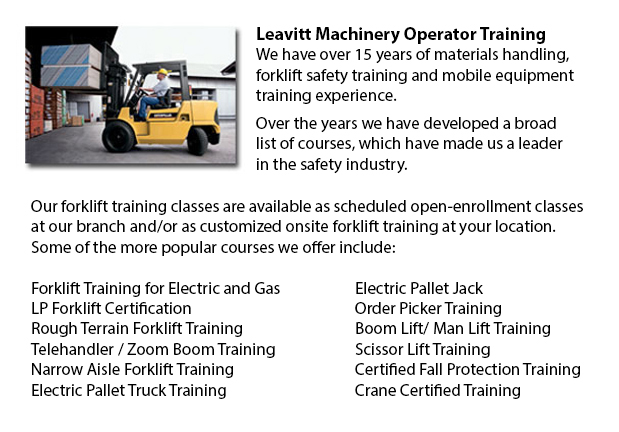
Rough Terrain Forklifts Training Toronto - There are in fact two unique kinds of lift trucks within the material handling industry, the industrial model and the rough terrain model. Rough terrain lift trucks initially came on the market in the 1940's and were predominantly used on irregular surfaces, ideal for areas where no covered roads were accessible, like building sites and lumberyards.
Rough ground lift trucks usually utilize an internal combustion engine with a battery for power. The engines are able to function on propane, diesel or gasoline. A number of makers are playing with rough land forklifts that consume vegetable matter and run from ethanol. Large pneumatic tires with deep treads characterize these forklifts to allow them to latch onto the roughest soil type devoid of any slippage or drifting.
The initial styles of rough terrain forklifts were able to carry weights of up to 1000 lbs, with blades that could slide beneath the item, jack it a slight bit and then move it to an alternate location. After a decade on the market, all terrain vehicles were given additional carrying power to about 2000 lbs capacity. In the 1960's telescoping booms were added, enabling them to stack resources a good deal higher than in previous years. The telescoping design characteristic is a staple of most all terrain forklifts today. Present models are capable of handling well over 4000 lbs thanks to the continued enhancements over time. Telescoping ability has additionally improved with some models reaching a height of 35 feet. Worker safety has also become a focus with a lot of all terrain forklifts currently constructed are outfitted with an enclosed cab for the operator, as opposed to the older open air seating capacity.
The rough terrain forklifts on the market nowadays both run skillfully on unpaved surfaces and paved floors. This kind of all terrain forklift is marketed for its' versatility enabling the possibility for businesses to use one unit to transfer supplies from an outside working area into a warehouse.
-
Clark Forklift
Clark Forklift Forklift Training - Performing globally, there are at this time 350,000 Clark forklifts and lift vehicles in operation, with upwards of 250,000 of those in service in North America. Clark has five major lines of lift trucks across the... More -
Doosan Forklift
Doosan Forklift Training Toronto - Doosan Infracore Company Ltd. is an intercontinental establishment consisting of Diesel Engines, Defense Industry products, Industrial Vehicles, Construction Technologies and Machine Instruments and Computerization... More -
Komatsu Forklift
Komatsu Forklift Training Toronto - Komatsu Forklift U.S.A. Inc. has an outstanding reputation for building reliable and rugged forklifts. Komatsu is recognized around the world as a business with a rich heritage while maintaining an exceptional stan... More -
Crown Forklift
More -
Genie Forklift
Genie Forklift Training Toronto - Genie is a universally predictable company that enjoys the spirit of collaboration with their vast network of associated customers. Genie Industries prides itself on the vision of bringing materials and people higher... More

Forklift Certification Toronto
TOLL FREE: 1-888-254-6157
Toronto, Ontario
forkliftcertificationtoronto.com
Email Us
About Us


